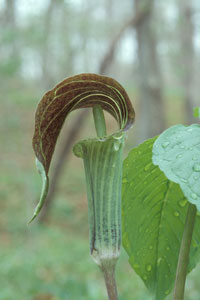
By Dan Zarlenga, Missouri Department of Conservation
Photo Caption: A Jack-in-the-pulpit spreads the gospel of spring throughout the forest. Photo courtesy the Missouri Department of Conservation
April is the time of year to spread the good word of nature. A visit to a nearby forest might seem to some like a religious experience. The miracle of life erupts from the trees and ground as leaf buds burst open and early spring flowers resurrect themselves after three months of winter’s lifelessness. Amidst psalms of migrating warblers and crooning amphibians, an unusual preacher emerges from the forest floor. His name is Jack-in-the-pulpit.
Jack-in-the-pulpits are curious little plants. They grow in moist upland and bottomland forests and often at the bottoms of bluffs. They typically unfurl in April along with many of spring’s early ephemeral flowers.
The Jack-in-the-pulpit flower takes the form of tiny, upright club called a spadix. A modified leaf, that can sometimes have white and brown lengthwise markings, forms a shelter for the spadix. The bottom of the leaf is cylinder-shaped and holds the small flower vertically within it, with the canopy forming a gracefully curved cover for the top. The spadix peeks out from the opening, like a minute preacher delivering a sermon from a miniature green pulpit. The arrangement forms an unusual and striking sight on the forest bottom.
It turns out that there are both male and female versions of Jack-in-the-pulpit, so an astute observer catching one of these In the springtime woods might actually be seeing a Jill-in-the-pulpit.
Some of Jack-in-the-pulpit’s most loyal missionaries are the fungus gnats, who are responsible for pollinating the plant. These insects are encouraged to attend Jack’s sermon by a unique scent emitted by the plant, where they become trapped within the flower. The bugs can manage to escape from Jack’s pulpit, but not without acquiring a tithe of pollen. When they find their way into a Jill’s pulpit, they deposit their donations and help expand the flock, so to speak.
Interestingly, Jack-in-the-pulpits avoid self-pollination because the male flowers on the plant mature and die before the female flowers of that same plant mature. This ensures that female flowers must be pollinated by the male flowers of another plant, which increases genetic diversity in the species. Jack-in-the-pulpit has a devilish side, however. The plants are toxic to eat, and even cause a skin rash if some people touch them. Despite their toxicity, Native Americans found a way to utilize the plants by drying the rootstock and grinding it into a kind of flour. Cooking and processing the correct way will make them edible. In fact, an alternate name for the plant is “Indian turnip”. It’s said though that the Fox Indians would sometimes mix the chopped raw plant with meat and leave it for their enemies to find, which could result in a last supper for the unfortunate diners.
If you feel inspired to carefully explore the floor of a woodland or forest near you, you might find the distinctive Jack-in-the-pulpit for yourself. When it comes time to spread the gospel of spring, these small preachers are ready.


